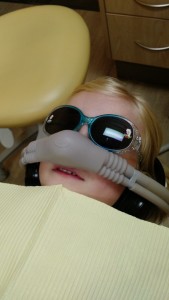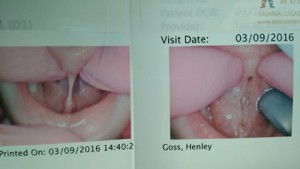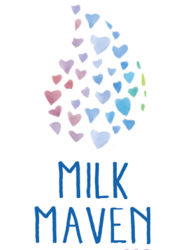
This is my daughter Henley. She is six years old. She loves Barbies, her pink scooter, and dresses with leggings. She was also born with a class 1 tongue tie, which means her tongue was heart shaped. It couldn’t move past her gum line, or lift at all from the bottom of her mouth. She clicked constantly when she was breastfeeding. We had it scissor clipped by an ENT when she was three days old. She was then able to nurse, but couldn’t handle my milk flow, never comfort nursed, and was addicted to pacifiers. She weaned at 21 months. She has always had trouble with balance (didn’t walk until 16 months), swallowing solids without choking, saying certain consonant sounds, and had recently developed a stutter. I knew her tongue was tied, and that it needed to be revised before it caused lasting orthodontia issues or speech pathology. We decided to take her to a pediatric dentist to have her tongue released via laser this time. Here is the interview I conducted with her after the procedure.
Me: So, tell me about your tongue.
Her: My tongue was tied, which meant I couldn’t touch my teeth with my tongue. The string under my tongue was too tight and it hurt when I chewed or talked a lot. [It should be said she said nothing about pain to me until she was in the parking lot of the dentist’s office and I told her what to expect. She said, “Mommy, will this help the string on my tongue not hurt so bad?”]
Me: So what happened at the dentist’s office?
Her: They let me watch Rio 2, and put special lipstick [chapstick] on my mouth so it wouldn’t dry out, and I wore cool shades.
Me: Did it hurt?
Her: It wasn’t ouchy because they gave me stuff to breathe that made me feel funny, then poked my tongue and it went to sleep.

Me: Did you see what they cut your tongue with?
Her: The laser looked like a TINY pen with a light on the end. Like a flashlight for a mouse.
Me: Were you scared?

Her: No. The dentist was nice, and covered me with a comfy blanky, and you were there the whole time watching.
Me: What was your recovery like?
Her: My tongue was weird all day, and then that night it hurt. Then, I got ice cream to lick and Popsicles, and grape medicine [Children’s Advil] that made it go away.
Me: You know, I work with babies who are too little to take medicine for the pain, what would you say to them about your tongue and the procedure you had done?
Her: To not be afraid, and to stay close to your mommy all day so she can give you milk to make you feel better. Oh, and don’t ask to watch Frozen because it doesn’t work on their TV.
By the next day, her stutter was gone. She is still lazy about saying some of her letter sounds, but I have no doubt that will remedy itself with time and as her tongue heals. She likes to show everyone all the things she can now do without her tongue tie. She can stick it out, move it from side to side, and say Ls!


